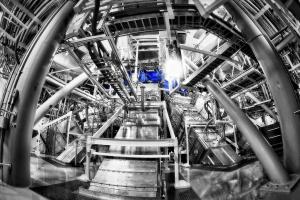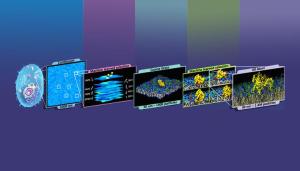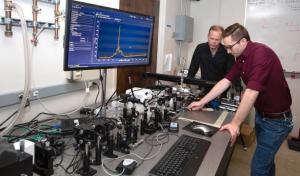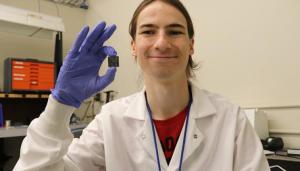LAB REPORT
Science and Technology Making Headlines
July 29, 2022


Uranus and Neptune both experience diamond rain. Image courtesy of NASA.
Diamonds in the sky
Two ice giants in our solar system experience diamond rain. On Neptune and Uranus, it rains diamonds.
While this is a striking reminder of how ordinary diamonds are in the greater scheme of this universe, it also sheds light on how elusive most terrains remain for humanity. Uranus and Neptune are both ice giants and also share a similar blue tint in terms of their appearance. For long, scientists have suspected that it rains diamonds on these planets.
The idea of a diamond rain on Uranus and Neptune was first put forward by Marvin Ross of Lawrence Livermore National Laboratory in a 1981 article published in Nature titled "The Ice Layer of Uranus and Neptune — Diamonds in the Sky?"
Ross' suggestion, as highlighted by American Scientist, is that high pressures and high temperatures inside the ice giants forces carbon and hydrogen atoms of methane to separate, squeezing them into a diamond structure.


NIF beamlines entering the lower hemisphere of the NIF Target Chamber, as seen from the ground floor of the Target Bay.
Fission vs. Fusion
Clean and sustainable nuclear energy may sound like a washed up, post-war dream, but the modern reality of this power source is much more complicated. For one, nuclear energy in the coming decades will include not only nuclear fission — the type of reaction already driving nuclear power plants — but also the much more elusive nuclear fusion.
If scientists can solve the remaining puzzle pieces behind these technologies, both nuclear fission and fusion are poised to have a big impact on the world’s energy reserves and green energy efforts in the coming decades. But before they do, let’s set the record straight on how these two similar sounding energy sources truly differ.
Unlike its sibling, nuclear fusion has largely been restricted to the realm of science fiction until recently. Instead of breaking something apart, nuclear fusion happens when light atoms are smashed together to create a heavier atom (e.g. two hydrogen atoms combining to form one helium atom). This interaction creates a huge burst of energy that is still burning at the heart of stars all across the universe.
The National Ignition Facility (NIF) and France’s International Thermonuclear Experimental Reactor (ITER) have made progress in recent years with NIF reporting last summer that their reactor was able to generate up to 70% of its input energy. Start-ups like Helion Energy are also working toward this goal using magnetic coils to compression the reactor core.
Scientists have claimed to be on the brink of cracking nuclear fusion for decades, but hopefully with any luck that promise may finally be coming.

LLNL researchers will use their recently awarded cycles on the world’s first exascale system — Frontier at Oak Ridge National Laboratory — to advance their work applying their Multiscale Machine-Learned Modeling Infrastructure computing framework and artificial intelligence to model and predict how RAS and RAF proteins interact with each other and with lipids on a realistic cell membrane.
Cancer research goes exascale
A Lawrence Livermore National Laboratory (LLNL) team will be among the first researchers to perform work on the world’s first exascale supercomputer — Oak Ridge National Laboratory’s Frontier — when they use the system to model cancer-causing protein mutations.
Led by Harsh Bhatia, a computer scientist in the Center for Applied Scientific Computing at LLNL, the team was awarded limited access to Frontier under the Department of Energy’s (DOE) Advanced Scientific Computing Research Leadership Computing Challenge program.
The program recently announced new funding for 45 scientific projects at universities, industry and government agencies, totaling 18 million node‐hours. The projects will use compute cycles at Lawrence Berkeley National Laboratory’s National Energy Research Scientific Computing Center and the Leadership Computing Facilities at Argonne and Oak Ridge national laboratories, including early access to a few select projects on Frontier.
The projects, with applications ranging from advanced energy systems to climate change and cancer research, will use DOE supercomputers to uncover unique insights about scientific problems that would otherwise be impossible to solve using experimental approaches, according to DOE.
Over the next year, Bhatia and his team will use the cycles to advance their previous work, applying their Multiscale Machine-Learned Modeling Infrastructure computing framework and artificial intelligence (AI) to model and predict how RAS and RAF proteins interact with each other and with lipids on a realistic cell membrane. Through the AI-Driven Multiscale Investigation of RAS-RAF Activation Lifecycle project, the researchers hope to gain an understanding of how the proteins mutate and cause tumors to form. Mutations in RAS are linked to about a third of all cancers, including pancreatic, colorectal and lung cancer.


Lab researchers Mark Burton (front right) and Jonathan Crowhurst align the laser ablation chamber for in-situ analysis of uranium oxide particulates.
So cool, it’s hot
A team of researchers from Lawrence Livermore and the University of Michigan has found that the rate of cooling in reactions dramatically affects the type of uranium molecules that form.
The team's experimental work, conducted over about a year and a half starting in October 2020, attempts to help understand what uranium compounds might form in the environment after a nuclear event.
"One of our most important findings was learning that the rate of cooling affects the behavior of uranium," said Mark Burton, the paper's lead author and a chemist in the Lab's Materials Science Division. "The big picture here is that we want to understand uranium chemistry in energetic environments."
In their experiments, the LLNL and Michigan researchers found that the rate of cooling — as well as the amount of oxygen — dramatically affects how uranium combines with oxygen. The recent experiments showed that as uranium cools from a plasma at about 10,000 degrees Celsius in microseconds (millionths of a second), the chemistry is drastically different when compared to cooling over milliseconds (thousandths of a second).

LLNL summer intern Oliver Philbrick holds a component he produced as part of a proof-of-concept project involving scale-up of 3D-printed carbon aerogels using customized feedstocks and a light-based 3D-printing technique. Aerogels are a unique class of low-density, high-surface-area, durable materials that present huge potential advances for scientific research and industrial applications.
Interning for energy storage
A visit to Lawrence Livermore National Laboratory (LLNL) last summer by a university professor led to a unique internship opportunity for an undergraduate student this summer: helping LLNL scientists fabricate higher-performing carbon aerogel structures for electrodes and other energy-storage applications.
In 2021, Professor Anthony Santamaria from Western New England (WNE) University in Massachusetts visited LLNL during a brief sabbatical to learn more about how LLNL scientists use 3D-printing technology to fabricate aerogel materials. During his visit, hosted by LLNL chemical engineer Marcus Worsley, he was able to produce aerogel materials with a variety of architectures, which he brought back to WNE to test during the academic year.
Summer intern Oliver Philbrick, who is earning a mechanical engineering degree at WNE, was one of the students who helped with the performance testing at WNE. When Philbrick learned about the opportunity to come to LLNL as an intern for follow-on work, he was eager to apply, hoping to expand his experience from testing 3D-printed parts to fabricating new designs.
During his 12-week internship at LLNL this summer through the LLNL’s Materials and Chemistry Institute summer internship program, Philbrick is working on a proof-of-concept for scaled-up, 3D-printed carbon aerogels using customized feedstocks and a light-based 3D-printing technique known as stereolithography. The goal is to analyze whether it is possible to engineer microporous, electrically conductive lattice networks in the material, so it can be used for fuel cell applications where lightweight, highly tailored shapes are needed.





